In Chicago’s Roseland Neighborhood, a Mix of Grief and Perseverance
This story is part of a larger project led by Lakeidra Chavis, a 2020 Data Fellow, who is reporting on how the pandemic has affected shooting survivors in Chicago.
Her other stories include:
More Than 30,000 People Shot In Chicago In 10 Years. Here’s What Survivors Say Is Needed.
Chicago Shooting Survivors Face Recovery With Few Resources
Introducing “Aftershocks,” a Series About Surviving Gun Violence in Chicago
How We Reported on Illinois’s Victim Compensation Program
How to Report on Victims Compensation in Your State
Part 2: Illinois Has a Program to Compensate Victims of Violent Crimes. Few Applicants Receive Funds.
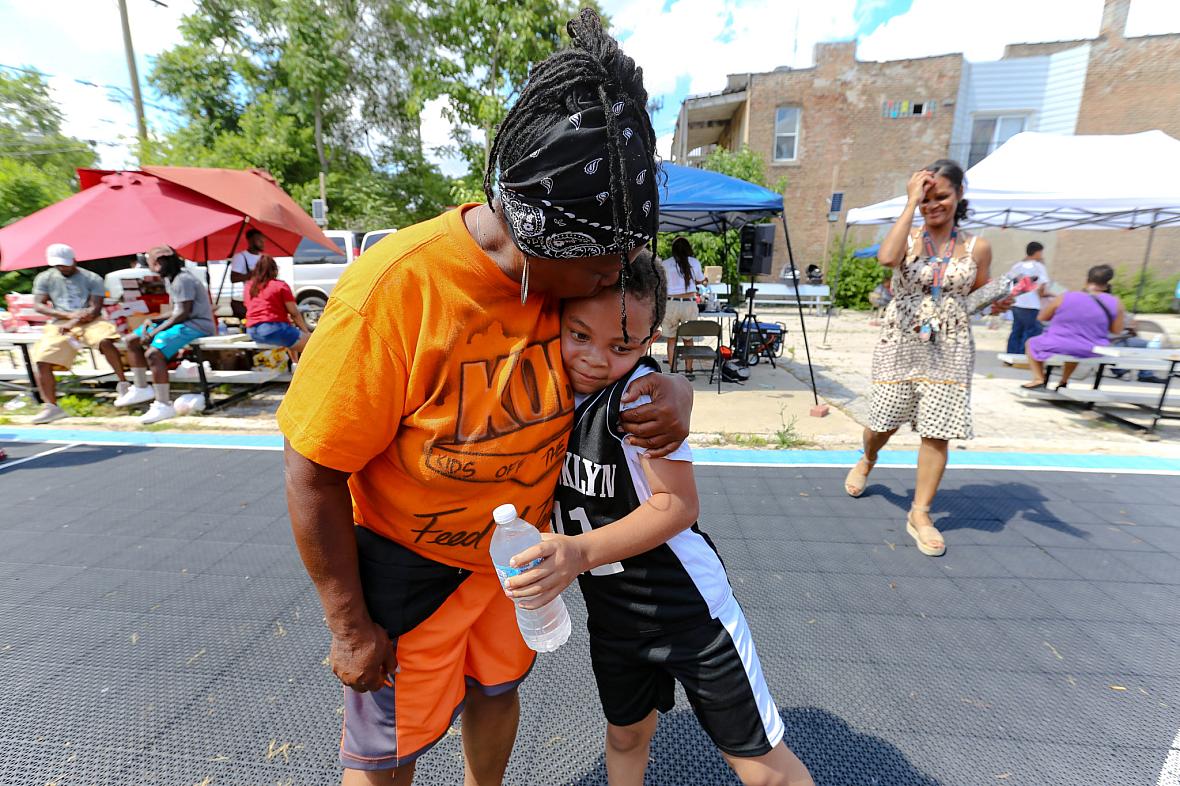
Olivia Obineme for The Trace
This story was published in partnership with Block Club Chicago and La Raza Chicago.
Residents in Roseland know the hut well, with its bright red hearts and urgent text imploring passersby to “Save a teen / Do something.” It’s a memorial near 117th and South Michigan, filled with rows of concrete blocks — each one inscribed in permanent marker with the name of a young person lost to gun violence.
Briahna Williams, 10; Victoria Dystar, 24; Duane King, 22; Fernando Maywood, 17. Just four out of some 800 victims.
The Kids Off the Block memorial, known in Roseland as the hut, pays tribute to hundreds of young victims of gun violence. Olivia Obineme for The Trace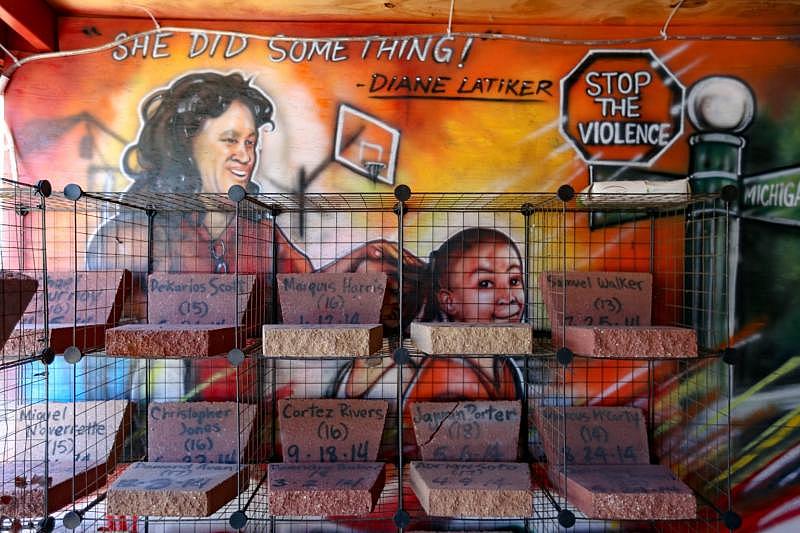
Roseland, the predominantly Black community on Chicago’s South Side, is often overlooked in discussions about the toll of gun violence in Chicago. Roseland hasn’t seen large spikes in crime compared to other South Side areas like Englewood or Fuller Park, nor does it face the level of violence found in the West Side communities of Austin or North Lawndale.
Still, in the past decade, more than 1,200 people have been shot in Roseland. Most survived, creating a pervasive sense of devastation that lingers over the neighborhood. This year alone, police data shows, more than 60 people were shot here.
At the same time, places like Roseland are just as defined by resilience as they are by loss. Diane Latiker, who built the memorial, wants people to know that residents care about Roseland in spite of the violence. “There are people here who are resilient, people here are still trying, still helping one another,” she said.
The story of Roseland — with its struggling commercial district, vacant lots, and few grocery stores — is emblematic of many Chicago neighborhoods, whose predominantly Black and Latinx communities face persistent violence. Shared causes include deep-seated inequities related to health and the environment. Compared to the city’s predominantly white areas, data from the Centers for Disease Control and Prevention shows that these communities face higher rates of asthma, cancer, and mental health diagnoses. A recent city health report found that life expectancy for Black Chicagoans was 9 years shorter than other residents’.
For residents in Roseland, the perception of gun violence largely depends on where someone lives, and the differences can be pronounced even on the same block. Some describe dodging drive-bys, while others hear gunshots so frequently that they can tell the difference between the sound of a .38-caliber revolver and an assault-style rifle. The Trace asked seven residents to describe their community in one word. They called it: Acceptable. A Village. Quiet. Horrific. Dangerous. Depressing. Resilient.
Diane Latiker outside the Kids Off the Block memorial in Roseland. Olivia Obineme for The Trace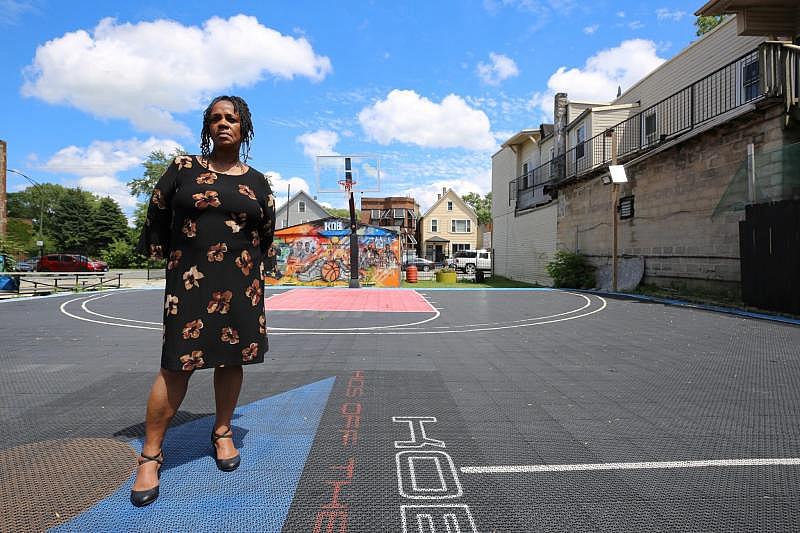
As in other Chicago neighborhoods, Roseland residents often mark loss by city streets: A friend shot and killed near 117th Street and St. Louis Avenue. A niece shot on 58th and Halsted Street. A nephew on Wentworth Avenue.
The memorial sits across the street from Latiker’s home. She created it more than a decade ago, after 16-year-old Blair Holt was shot on a school bus nearby. He was killed shielding his classmates from gunfire.
“Everybody wanted to march, and I didn’t want to do that,” said Latiker. Instead, she went to Home Depot, and found the thing she didn’t know she was looking for. “They looked like small headstones,” she said. The memorial uses those concrete blocks to pay tribute to the people Chicago lost.
People often don’t realize how cyclical issues like gun violence are, Latiker said. “When something violent happens in their family, [the youth] look for that safe space in the community, [and] oftentimes it’s not there,” she said. “Society has disconnected. Society puts them in this situation and expects them to excel, to not be angry, to not be involved in gangs…[so] you’re always at the bottom of the totem pole.”
Making matters worse, there’s little relief or justice. Since 2010, data shows, police have ended half of all shooting investigations in Roseland after just one month. Only 5 percent resulted in arrests. The majority of gun violence victims in the area are Black.
Just as prevalent as the deaths Latiker chronicles are the stories of community members fighting to move forward after tragedy, working to make the neighborhoods they love safer. Trevon Bosley is one of them.
As a young boy, Bosley already had an intimate understanding of grief. At age 7, his cousin was fatally shot. Less than six months later, his brother Terrell, 18, was killed outside the church where he played bass. Terrell loved Gospel music, and was the kind of kid who knew everybody. His death threw the Bosley family into a deep, years-long depression, a period Trevon recalls as “nothingness and hopelessness.”
Trevon Bosley, who grew up in Roseland, wears a necklace in memory of his late brother, Terrell, who was fatally shot. Olivia Obineme for The Trace
Trevon Bosley, who grew up in Roseland, wears a necklace in memory of his late brother, Terrell, who was fatally shot. Olivia Obineme for The Trace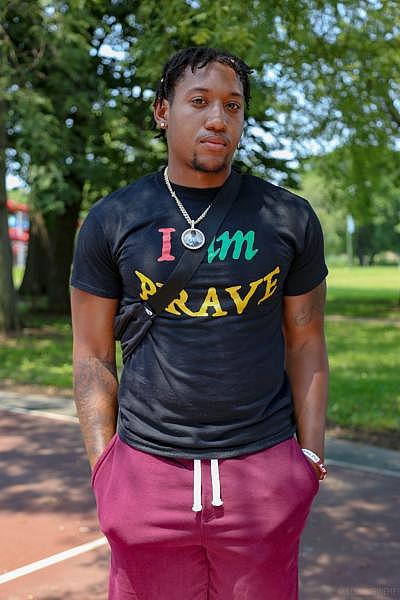
The Bosleys sought closure through violence prevention work. Trevon began working with St. Sabina, a storied Catholic Church on the South Side. He joined BRAVE, a youth-led leadership program. He eventually met President Barack Obama and spoke at the March for Our Lives rally. His mother co-founded Purpose Over Pain, a nonprofit that hosts events and helps residents affected by gun violence. His father helps people who have been released from prison find jobs.
“Through my brother’s loss, I wanted to make sure that I’m creating some form of change, something that he would want,” Bosley said. “His killer was never caught, like a lot of cases in Chicago. I just feel like I need to keep his name alive and provide him some form of justice.”
Bosley’s family arrived in Chicago during the Great Migration. He was born and raised in Roseland near 105th Street and Rhodes Avenue. Although he grew up hearing gunshots and sirens, when he looks at his community, he sees beauty and strength.
“It’s a lot of love in Roseland,” he said. “You can go to a random basketball court and hoop with anybody, and just interact with people walking down the street. It’s a positive vibe. I know all of my neighbors, and all of them have been supportive and watched me grow up.”
The first wave of the coronavirus pandemic hit Roseland particularly hard. Almost everyone in Bosley’s family contracted the virus, including his parents. His great-grandfather died from the disease.
Now 23, Bosley is studying electrical engineering at Southern Illinois University, Edwardsville. He wants to create medical equipment to help save shooting victims. “I wish there was some form of technology to save my brother,” Bosley said. “I want to be able to build some form of technology that can help us survive.”
Roseland wasn’t always like this. It started as a village of Dutch immigrants nearly 200 years ago, historical records show, named after the roses that grew here. The City of Chicago annexed the area in the late 1800s, before Roseland would grow into the bustling commercial district it later became known for.
During the 1960s, Black people migrated there from down South. Within a generation, the community was predominantly Black. But then, the steel and automotive industries collapsed in the 1980’s, leaving Roseland and many other South Side communities in disrepair.
During a hot afternoon windy enough to carry dandelion seeds through the air, Ledall Edwards sat on the orange leather chair in his clothing store and gazed out onto the Roseland Business District. The district runs several blocks along South Michigan Avenue, but it’s a long way from the wealthy Michigan Avenue several miles north in downtown, pitched to tourists as The Magnificent Mile.
His father opened Edwards Fashions in 1974, when the strip was vibrant. Now, most of the stores along the strip are now closed or boarded up. Some shop owners say even more stores closed because of the pandemic, and others didn’t reopen after last summer’s riots.
“There’s a segment of the population that really doesn’t want to be here, they’re here to save money and move out and go to other areas where there’s better schools, where they feel safer, and access to more goods and services,” said Edwards. “A lot of things are missing. We don’t have a grocery store, a sit-down restaurant, a cleaner’s. That forces people [to] go outside of the community.”
Ledall Edwards stands on the floor of Edwards Fashions, which his father opened in 1974 on Roseland’s South Michigan Avenue. He now runs the store with his nephew. Olivia Obineme for The Trace
Most of his customers used to live in Roseland, but many have since moved away. Edwards believes the community still has potential — it just needs more government investment in local businesses and housing. Last year, a preservation group named the business district as one of the most endangered historic areas in the city. “It’s good people in this neighborhood,” Edwards said. “They want the same thing most people want.”
The remnants of neglect are evident along the business district and sprawl into residential side streets. In the past decade, Whole Foods set up shop a short drive away, and a Culver’s burger spot is in development, investments that made news. But residents told The Trace they need more: More reasonable grocery stores, childcare, affordable housing, mental health clinics, and safe entertainment spaces. A whole lot more.
As alderman of the 9th Ward, which includes Roseland, Anthony Beale says he has worked to bring many opportunities back to his area, including Walmart, Ross, Planet Fitness, a community center, and a food hall. But these businesses opened in nearby Pullman and West Pullman — not in Roseland.
That’s because businesses are attracted to large areas of land and highways, Beale says, features that Roseland lacks. “You’re not going to put a Walmart on Michigan Avenue,” he said. “It’s not going to work.”
Edwards bristled at Beale’s assessment, and says that if people have to constantly leave their neighborhood to seek services, then they don’t really have a community to live in.
Even while he touts these new investments, Beale, too, has nostalgia for better times in Roseland. He grew up on the South Side and fondly recalls trips to places like Afro Aquatic & Pet Supplies. “I remember as a kid shopping along Michigan Avenue with my mother on Saturday morning,” Beale said. “All of these businesses knew us by name.”
Still, Beale believes the new businesses are good for all the South Side neighborhoods he represents, reachable in a quick drive. He says his ward is on the up and up.
A view of 112th Street and State Street in Roseland. Olivia Obineme for The Trace.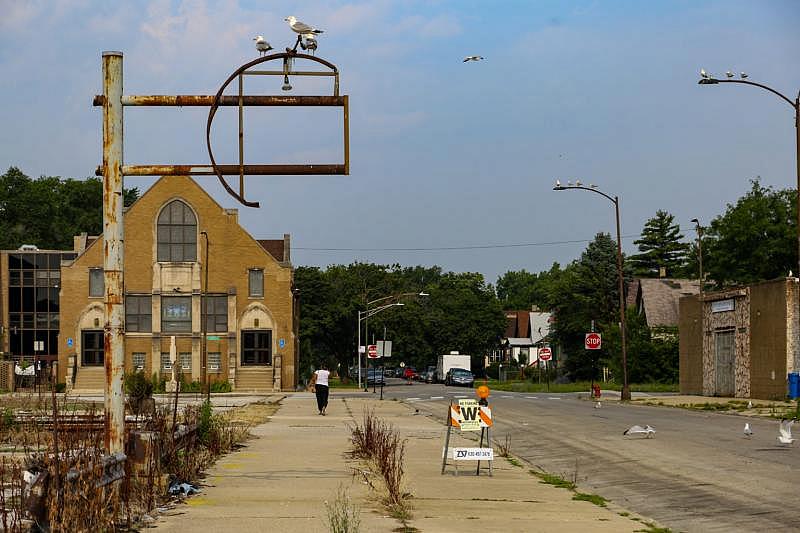
Loss was on Donnell Gardner’s mind ahead of Memorial Day Weekend. His son, Donnell Jr., was shot and killed last fall at age 29. “When you lose a loved one and you don’t got the resources… it ain’t a lot of moving forward,” he said, leaning against a brick office building.
Gardner remembers his son as handy and fun to be around. “His jokes weren’t that funny, but at least he tried [but] he would always come back with another one,” Gardner recalled. “It was a big, tremendous loss to my family. He’s truly missed.”
And it wasn’t just his son. Two of Gardner’s friends had been shot a few days earlier on 46th and Federal Street. His grandmother had recently died. He lost an uncle to COVID-19 and another to cancer. “It’s becoming the norm for us Black folks living in Roseland and West Pullman, coming from the low end of the city of Chicago… we just stuck in the dark.”
Gardner is a street outreach worker for Chicago CRED, one of the many organizations focused on improving the community. Almost every day, Gardner and his colleagues canvas the streets of Roseland and West Pullman. They aim to build relationships with men and women most at risk of gun violence, and to try and stop retaliatory shootings before they happen by mediating conflicts between rival groups.
On a recent afternoon the CRED team started its day with two shootings to follow up on: a fatal one on 113th Street and Michigan Avenue, and another near a sandwich shop on 107th and State Street.
Chicago CRED street outreach workers canvas the Pullman and Roseland neighborhoods on a recent Saturday. Former U.S. Secretary of Education Arne Duncan launched the group after a historic spike in gun violence in 2016. Olivia Obineme for The Trace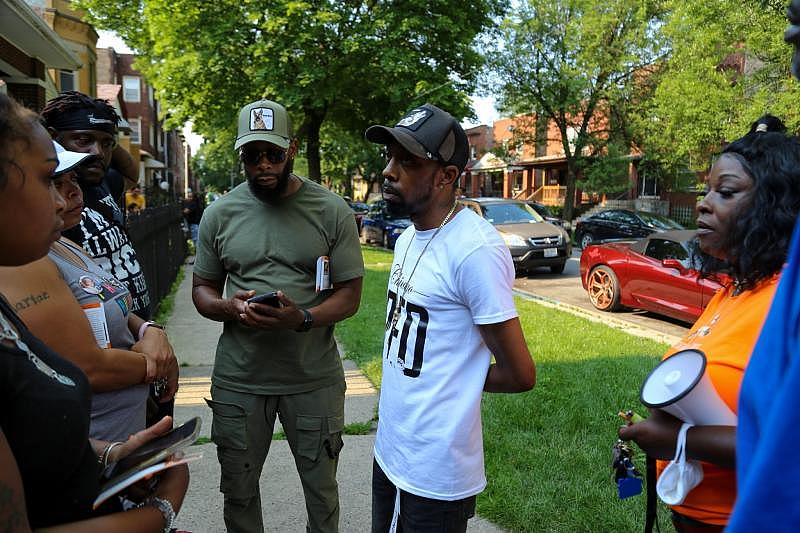
Trevon Bosley compares gun violence to a tree. “Gun violence is the branches and the entire foliage, but most people don’t see the roots,” he said. “The failing education system, the resources we don’t have, [and] the lack of funding for afterschool programs.”
Bosley says it’s important to understand that those affected by this issue in the city aren’t numbers. They’re people.
This story was produced as a project for the USC Annenberg Center for Health Journalism’s 2020 Data Fellowship.
[This story was originally published by The Trace.]

